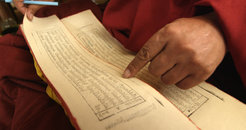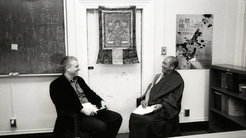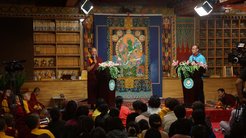Rethinking of Social Scientific Study of Religion – metanotes from the field, summer 2013
by Dan Smyer Yu
Usually before fieldwork or after returning from it, I ask myself, “Where am I?” “What is that distance that separates me from my ethnographic field?” and I think about the fact that the difference is not just a geographic distance that a jet plane can overcome in ten hours.



Where I am now – a research institution known for its social scientific study of religion and ethnicity – is the place where I transform fieldnotes, which are yielded from my observation of and participation in events and activities in different communities in far-off places, into ethnographies laden with critical perspectives, anthropological interpretations, and theoretical engagements with those of my peers. This is a common practice of the social scientist who streamlines the production of cultural knowledge or facilitates the process of what James Clifford, George Marcus and others call “writing culture.” This, and Clifford Geertz’s “interpretation of cultures” aren’t merely literal phrases representing concerned theoretical perspectives but, most critically, are ingredients of the disciplinary indoctrination of several generations of anthropologists, myself included.
Do these phrases address my reflexive questions? Yes! But, do they social-scientifically solidify my ethnographic claims? Not entirely. The idea or the question of “science” remains a point of debate and contention not only among social scientists and scholars situated in the disciplines of humanities, but also among those who are the subjects of said social scientific research and who, with intellectual sophistication, are aware of the social implications of the social scientific representations of human cultural practices.

Then, my ethnographies are not purely social scientific texts but are “the fictions of factual representation” from the perspective of Hayden White’s literary critique. As revealing of the social scientific production of knowledge as this classic phrase suggests, “fiction,” “fact,” and “representation” deserve scrutiny from all possible angles. The emphasis here, then, is set on a “fact” concerning the dichotomy, intersection, and mutual saturation of religion and science in a case of contemporary Buddhist attempts to claim a wider global presence of ancient teachings.

Since March this year I have documented a Buddhism-and-science dialogue project involving Khenpo Sodargye, a very publicly active Tibetan lama in China, and scholars in the fields of anthropology, Buddhist Studies, geography, and religious studies.




From Khenpo’s dialogues with his academic counterparts at Columbia, Georgetown, Harvard, Max Planck, and other places housing active research programs concerning new trends of religious practices, I see:
(1) ethnography as a field science (Gupta and Ferguson) no longer supports the disciplinary unconscious of an anthropological field as somewhere “out there” in a distant land of the natives;

(2) the boundary between the field and the home of the social scientist is porous and oftentimes is de facto breached given the globe-wide movements of humans, especially when those who are traditionally regarded as social scientific “research subjects” invite themselves into the home space of the social scientists. To put it plainly, they are researching us and challenging our knowledge production, too;

(3) Religion-science dialogue is not new; however, it is a new trend that Buddhists on the global scale are becoming more and more fluent in adopting modern scientific terminology to advance their global spiritual interests;
(4) Global-minded Buddhist masters do not stop at their adoption of modern scientific representation of Buddhist teachings; instead they are taking steps further and deeper to claim Buddhism as a science of its own, namely a science of the mind;

(5) On one hand, modern science is being turned into a vessel by Buddhist masters, who, in my observation, carry on the transhistorical mission of Buddhism – dissemination of Buddha Dharma worldwide. On the other hand, modern science is under epistemic critiques and even attacks from a growing number of Buddhist teachers and scholars;
(6) The canonic/iconic ground of “science” in the secular realm is being subverted. It no longer stands as the singular systematic body of knowledge; instead it is being pluralized, relativized, and (in)voluntarily democratized when religious practitioners claim to be scientists in their own right. I’m not saying Buddhism is not a system of knowledge. In fact it is, but many of its masters are taking a “scientific route” to propagate it; thus modern science has utilitarian value to Buddhists but has little role to play in the ultimate mission of Buddhism, as it is often typecast as a science of the material, not of the spiritual by intellectually sophisticated Buddhists;
(7) The anti-religious, atheistic past of the social scientific study of religion becomes the critical ground on which Buddhist masters like Khenpo Sodargye level criticism at the “scientific destruction of religion” especially in the cases of former/current socialist nation-states such as the Soviet Union, China, and North Korea. This historical aspect is being labeled as “scientific ignorance” (Khenpo Sodargye);
(8) Finally religion and science continue to mark their own distinctions in public but transpersonally penetrate and accommodate each other in private. Progressive Buddhist teachers seem to be more comfortable marketing themselves as both religious practitioners and inner scientists, whereas most social scientists who practice Buddhism hide their Buddhist mode of being in their closets in fear of being looked upon as “unscientific” from the eye of their peers;
Is the social scientific study of religion collapsing in the case of Buddhist studies? Not at all! Social sciences are not and will not be natural sciences. Neither will they become a religion. The Buddhist allegation of modern science as a knowledge system that only concerns material phenomenon does not qualify what and how social scientists study religions. Those of us who are qualitatively oriented know better that what is designated as the psyche, the inner realm, or the mind projects itself outward and establish itself with its social materiality in spatial terms, not just in abstract ideas. A mindscape has its corresponding landscape and vice versa as I discuss in my forthcoming book Mindscaping the Landscape of Tibet: Place, Memorability, Eco-aesthetics (De Gruyter, March 2014).























